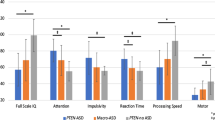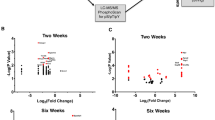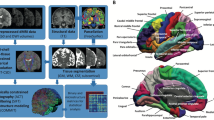Abstract
PTEN is a tumor suppressor associated with an inherited cancer syndrome and an important regulator of ongoing neural connectivity and plasticity. The present study examined molecular and phenotypic characteristics of individuals with germline heterozygous PTEN mutations and autism spectrum disorder (ASD) (PTEN-ASD), with the aim of identifying pathophysiologic markers that specifically associate with PTEN-ASD and that may serve as targets for future treatment trials. PTEN-ASD patients (n=17) were compared with idiopathic (non-PTEN) ASD patients with (macro-ASD, n=16) and without macrocephaly (normo-ASD, n=38) and healthy controls (n=14). Group differences were evaluated for PTEN pathway protein expression levels, global and regional structural brain volumes and cortical thickness measures, neurocognition and adaptive behavior. RNA expression patterns and brain characteristics of a murine model of Pten mislocalization were used to further evaluate abnormalities observed in human PTEN-ASD patients. PTEN-ASD had a high proportion of missense mutations and showed reduced PTEN protein levels. Compared with the other groups, prominent white-matter and cognitive abnormalities were specifically associated with PTEN-ASD patients, with strong reductions in processing speed and working memory. White-matter abnormalities mediated the relationship between PTEN protein reductions and reduced cognitive ability. The Ptenm3m4 murine model had differential expression of genes related to myelination and increased corpus callosum. Processing speed and working memory deficits and white-matter abnormalities may serve as useful features that signal clinicians that PTEN is etiologic and prompting referral to genetic professionals for gene testing, genetic counseling and cancer risk management; and could reveal treatment targets in trials of treatments for PTEN-ASD.
This is a preview of subscription content, access via your institution
Access options
Subscribe to this journal
Receive 12 print issues and online access
$259.00 per year
only $21.58 per issue
Buy this article
- Purchase on Springer Link
- Instant access to full article PDF
Prices may be subject to local taxes which are calculated during checkout


Similar content being viewed by others
Accession codes
References
Ronald A, Hoekstra RA . Autism spectrum disorders and autistic traits: a decade of new twin studies. Am J Med Genet B Neuropsychiatr Genet 2011; 156B: 255–274.
Abrahams BS, Geschwind DH . Advances in autism genetics: on the threshold of a new neurobiology. Nat Rev Genet 2008; 9: 341–355.
Sebat J, Lakshmi B, Malhotra D, Troge J, Lese-Martin C, Walsh T et al. Strong association of de novo copy number mutations with autism. Science 2007; 316: 445–449.
Levy D, Ronemus M, Yamrom B, Lee YH, Leotta A, Kendall J et al. Rare de novo and transmitted copy-number variation in autistic spectrum disorders. Neuron 2011; 70: 886–897.
Sanders SJ, Ercan-Sencicek AG, Hus V, Luo R, Murtha MT, Moreno-De-Luca D et al. Multiple recurrent de novo CNVs, including duplications of the 7q11.23 williams syndrome region, are strongly associated with autism. Neuron 2011; 70: 863–885.
O'Roak BJ, Deriziotis P, Lee C, Vives L, Schwartz JJ, Girirajan S et al. Exome sequencing in sporadic autism spectrum disorders identifies severe de novo mutations. Nat Genet 2011; 43: 585–589.
O'Roak BJ, Vives L, Fu W, Egertson JD, Stanaway IB, Phelps IG et al. Multiplex targeted sequencing identifies recurrently mutated genes in autism spectrum disorders. Science 2012; 338: 1619–1622.
van Diepen MT, Eickholt BJ . Function of PTEN during the formation and maintenance of neuronal circuits in the brain. Dev Neurosci 2008; 30: 59–64.
Page DT, Kuti OJ, Prestia C, Sur M . Haploinsufficiency for Pten and Serotonin transporter cooperatively influences brain size and social behavior. Proc Natl Acad Sci USA 2009; 106: 1989–1994.
Kwon CH, Luikart BW, Powell CM, Zhou J, Matheny SA, Zhang W et al. Pten regulates neuronal arborization and social interaction in mice. Neuron 2006; 50: 377–388.
Amiri A, Cho W, Zhou J, Birnbaum SG, Sinton CM, McKay RM et al. Pten deletion in adult hippocampal neural stem/progenitor cells causes cellular abnormalities and alters neurogenesis. J Neurosci 2012; 32: 5880–5890.
Frazier TW, Hardan AY . A meta-analysis of the corpus callosum in autism. Biol Psychiatry 2009; 66: 935–941.
Just MA, Cherkassky VL, Keller TA, Kana RK, Minshew NJ . Functional and anatomical cortical underconnectivity in autism: evidence from an FMRI study of an executive function task and corpus callosum morphometry. Cereb Cortex 2007; 17: 951–961.
Fishman I, Keown CL, Lincoln AJ, Pineda JA, Muller RA . Atypical cross talk between mentalizing and mirror neuron networks in autism spectrum disorder. JAMA Psychiatry 2014; 71: 751–760.
Mester JL, Tilot AK, Rybicki LA, Frazier TW, Eng C . Analysis of prevalence and degree of macrocephaly in patients with germline PTEN mutations and of brain weight in Pten knock-in murine model. Eur J Hum Genet 2011; 19: 763–768.
Tilot AK, Gaugler MK, Yu Q, Romigh T, Yu W, Miller RH et al. Germline disruption of Pten localization causes enhanced sex-dependent social motivation and increased glial production. Hum Mol Genet 2014; 23: 3212–3227.
Trotman LC, Wang X, Alimonti A, Chen Z, Teruya-Feldstein J, Yang H et al. Ubiquitination regulates PTEN nuclear import and tumor suppression. Cell 2007; 128: 141–156.
Waterhouse L, Morris R, Allen D, Dunn M, Fein D, Feinstein C et al. Diagnosis and classification in autism. J Autism Dev Disord 1996; 26: 59–86.
Tan MH, Mester J, Peterson C, Yang Y, Chen JL, Rybicki LA et al. A clinical scoring system for selection of patients for PTEN mutation testing is proposed on the basis of a prospective study of 3042 probands. Am J Hum Genet 2012; 88: 42–56.
Eng C . PTEN: one gene, many syndromes. Hum Mutat 2003; 22: 183–198.
Busch RM, Chapin JS, Mester J, Ferguson L, Haut JS, Frazier TW et al. Cognitive characteristics of PTEN hamartoma tumor syndromes. Genet Med 2013; 15: 548–553.
Butler MG, Dasouki MJ, Zhou X-P, Talebizadeh Z, Brown M, Takahashi TN et al. Subset of individuals with autism spectrum disorders and extreme macrocephaly associated with germline PTEN tumour suppressor gene mutations. J Med Genet 2005; 42: 318–321.
Varga EA, Pastore M, Prior T, Herman GE, McBride KL . The prevalence of PTEN mutations in a clinical pediatric cohort with autism spectrum disorders, developmental delay, and macrocephaly. Genet Med 2009; 11: 111–117.
Orrico A, Galli L, Buoni S, Orsi A, Vonella G, Sorrentino V . Novel PTEN mutations in neurodevelopmental disorders and macrocephaly. Clin Genet 2009; 75: 195–198.
Buxbaum JD, Cai G, Chaste P, Nygren G, Goldsmith J, Reichert J, Anckarsäter H et al. Mutation screening of the PTEN gene in patients with autism spectrum disorders and macrocephaly. Am J Med Genet B Neuropsychiatr Genet 2007; 144B: 484–491.
Lainhart JE, Bigler ED, Bocian M, Coon H, Dinh E, Dawson G et al. Head circumference and height in autism: a study by the Collaborative Program of Excellence in autism. Am J Med Genet A 2006; 140: 2257–2274.
Vanderver A, Tonduti D, Kahn I, Schmidt J, Medne L, Vento J et al. Characteristic brain magnetic resonance imaging pattern in patients with macrocephaly and PTEN mutations. Am J Med Genet A 2014; 164: 627–633.
Lok C, Viseux V, Avril MF, Richard MA, Gondry-Jouet C, Deramond H et al. Brain magnetic resonance imaging in patients with Cowden syndrome. Medicine (Baltimore) 2005; 84: 129–136.
Flores AI, Narayanan SP, Morse EN, Shick HE, Yin X, Kidd G et al. Constitutively active Akt induces enhanced myelination in the CNS. J Neurosci 2008; 28: 7174–7183.
Jobim PF, Pedroso TR, Christoff RR, Werenicz A, Maurmann N, Reolon GK et al. Inhibition of mTOR by rapamycin in the amygdala or hippocampus impairs formation and reconsolidation of inhibitory avoidance memory. Neurobiol Learn Mem 2012; 97: 105–112.
Jobim PF, Pedroso TR, Werenicz A, Christoff RR, Maurmann N, Reolon GK et al. Impairment of object recognition memory by rapamycin inhibition of mTOR in the amygdala or hippocampus around the time of learning or reactivation. Behav Brain Res 2012; 228: 151–158.
Mac Callum PE, Hebert M, Adamec RE, Blundell J . Systemic inhibition of mTOR kinase via rapamycin disrupts consolidation and reconsolidation of auditory fear memory. Neurobiol Learn Mem 2014; 112: 176–185.
Zhou J, Blundell J, Ogawa S, Kwon CH, Zhang W, Sinton C et al. Pharmacological inhibition of mTORC1 suppresses anatomical, cellular, and behavioral abnormalities in neural-specific Pten knock-out mice. J Neurosci 2009; 29: 1773–1783.
Rutter M, Le Couteur A, Lord C . Autism Diagnostic Interview-Revised Manual. Western Psychological Services: Los Angeles, 2003.
Gotham K, Risi S, Pickles A, Lord C . The Autism Diagnostic Observation Schedule: revised algorithms for improved diagnostic validity. J Autism Dev Disord 2007; 37: 613–627.
Constantino JN, Gruber CP . Social Responsiveness Scale: Manual. Western Psychological Services: Los Angeles, CA, 2005.
Liaw D, Marsh DJ, Li J, Dahia PLM, Wang SI, Zheng Z et al. Germline mutations of the PTEN gene in Cowden disease, an inherited breast and thyroid cancer syndrome. Nat Genet 1997; 16: 64–67.
Mutter GL, Lin MC, Fitzgerald JT, Kum JB, Baak JP, Lees JA et al. Altered PTEN expression as a diagnostic marker for the earliest endometrial precancers. J Natl Cancer Inst 2000; 92: 924–930.
Zhou XP, Waite KA, Pilarski R, Hampel H, Fernandez MJ, Bos C et al. Germline PTEN promotor mutations and deletions in Cowden/Bannayan-Riley-Ruvalcaba syndrome result in aberrant PTEN protein and dysregulation of the phosphoinositol-3-kinase/Akt pathway. Am J Hum Genet 2003; 73: 404–411.
Fischl B . FreeSurfer. Neuroimage 2012; 62: 774–781.
Smith SM, Jenkinson M, Woolrich MW, Beckmann CF, Behrens TE, Johansen-Berg H et al. Advances in functional and structural MR image analysis and implementation as FSL. Neuroimage 2004; 23: S208–S219.
Bishop SL, Guthrie W, Coffing M, Lord C . Convergent validity of the Mullen Scales of Early Learning and the differential ability scales in children with autism spectrum disorders. Am J Intellect Dev Disabil 2011; 116: 331–343.
Mullen EM . Mullen Scales of Early Learning. American Guidance Service Inc: Circle Pines, MN, 1995.
Wechsler D . Manual for the Wechsler Abbreviated Scale of Intelligence. The Psychological Corporation: San Antonio, TX, 1999.
Conners CK . Conners' CPT II: Continuous Performance Test II: Technical Guide and Software Manual. Multi-Health Systems, Inc.: North Tonawanda, NY, 2000.
Sheslow D, Adams W . Wide Range Assessment of Memory and Learning Second Edition administration and technical manual. Psychological Assessment Resources: Lutz, FL, 2003.
Bruininks RH, Woodcock RW, Weatherman RF, Hill BK . Scales of Independent Behavior—Revised Comprehensive Manual. Riverside: Chicago, IL, 1996.
Fraser MM, Zhu X, Kwon C-HH, Uhlmann EJ, Gutmann DH, Baker SJ . Pten loss causes hypertrophy and increased proliferation of astrocytes in vivo. Cancer Res 2004; 64: 7773–7779.
Tatiana MK, Sunnen CN, Beth C, Gum Hwa L, Anne EA, Gabriella DA . Development and characterization of NEX-Pten, a novel forebrain excitatory neuron-specific knockout mouse. Dev Neurosci 2012; 34: 198–209.
Trapnell C, Hendrickson DG, Sauvageau M, Goff L, Rinn JL, Pachter L . Differential analysis of gene regulation at transcript resolution with RNA-seq. Nat Biotechnol 2013; 31: 46–53.
Trapnell C, Roberts A, Goff L, Pertea G, Kim D, Kelley DR et al. Differential gene and transcript expression analysis of RNA-seq experiments with TopHat and Cufflinks. Nat Protoc 2012; 7: 562–578.
Hanley JA, Negassa A, Edwardes MD, Forrester JE . Statistical analysis of correlated data using generalized estimating equations: an orientation. Am J Epidemiol 2003; 157: 364–375.
IBM Corp. IBM Statistics for Windows. 21.0 edn. IBM Corp: Armonk, NY, 2012.
IBM Corp. IBM SPSS Amos. 21.0 edn. IBM Corp: Armonk, NY, 2012.
Baron RM, Kenny DA . The moderator-mediator variable distinction in social psychological research: Conceptual, strategic, and statistical considerations. J Pers Soc Psychol 1986; 51: 1173–1182.
Borenstein M, Hedges LV, Rothstein H, Cohen J, Schoenfeld D SPSS. IBM SPSS SamplePower v3.0.1. IBM Corp: Somers, NY, 2011.
Acknowledgements
This work was made possible by the Case Western Reserve University/Cleveland Clinic CTSA Grant Number UL1 RR024989 provided by the National Center for Research Resources and the National Center for Advancing Translational Sciences, National Institutes of Health and a grant from the National Cancer Institute R01CA118980. We also wish to acknowledge the important contribution of the participants and their families.
Author information
Authors and Affiliations
Corresponding author
Ethics declarations
Competing interests
Dr Frazier has received federal funding or research support from, acted as a consultant to, received travel support from and/or received a speaker’s honorarium from the Simons Foundation, Ingalls Foundation, Forest Laboratories, Ecoeos, IntegraGen, Shire Development, Bristol-Myers Squibb, National Institutes of Health and the Brain and Behavior Research Foundation. Dr Eng has received research support from IntegraGen, was a Doris Duke Distinguished Clinical Scientist, holds the Sondra J and Stephen R Hardis Chair of Cancer Genomic Medicine at the Cleveland Clinic and is an ACS Clinical Research Professor.
Additional information
Supplementary Information accompanies the paper on the Molecular Psychiatry website
Supplementary information
PowerPoint slides
Rights and permissions
About this article
Cite this article
Frazier, T., Embacher, R., Tilot, A. et al. Molecular and phenotypic abnormalities in individuals with germline heterozygous PTEN mutations and autism. Mol Psychiatry 20, 1132–1138 (2015). https://doi.org/10.1038/mp.2014.125
Received:
Revised:
Accepted:
Published:
Issue Date:
DOI: https://doi.org/10.1038/mp.2014.125
This article is cited by
-
Longitudinal neurobehavioral profiles in children and young adults with PTEN hamartoma tumor syndrome and reliable methods for assessing neurobehavioral change
Journal of Neurodevelopmental Disorders (2023)
-
CHD8 mutations increase gliogenesis to enlarge brain size in the nonhuman primate
Cell Discovery (2023)
-
Behavioural and psychological features of PTEN mutations: a systematic review of the literature and meta-analysis of the prevalence of autism spectrum disorder characteristics
Journal of Neurodevelopmental Disorders (2022)
-
Tackling healthcare access barriers for individuals with autism from diagnosis to adulthood
Pediatric Research (2022)
-
Neuroimaging features of genetic syndromes associated with CNS overgrowth
Pediatric Radiology (2022)



